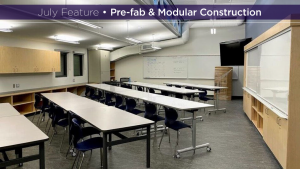Young architects and builders got a lesson on some of the industry’s pitfalls and how to avoid them during a seminar on “tales from the trenches” recently at the Construct Canada conference in Toronto.
Architect Brian Palmquist offered advice based on his book, An Architect’s Guide to Construction, a tome written from years of experience in the field.
The B.C.-based architect said from the outset of a project, building officials should receive assurances the project is constructed to code.
In B.C. three sets of assurances are required under Part 3 of the building code as a result of a supermarket that collapsed on opening day about 30 years ago in the Lower Mainland.
As a result, owners must retain an architect and halt the project if that architect is dismissed until another one is hired. The architect and engineer must stay through construction to assure the project is built to code.
“I am not a big believer in extra paperwork…but this has created real clarity about who does what with whom and to whom for most buildings,” he said, noting he believes the assurances are not yet a requirement in Ontario.
Palmquist, who taught for years at the University of B.C.’s School of Architecture, advised young architects to carefully track their time. He uses an app — Hours Keeper — to evaluate efficiency levels and at times “capture at least $1,000 a month.”
He said if a superintendent seems impatient with an architect’s requests, recognize their responsibilities are large and time is often limited.
His research while employed at Ledcor indicates the average superintendent manages about $50 million a year, or $8,000 an hour.
“It probably behooves you to think about how you can work really closely with them…because if they do not do a good job on your building it will not be a good building,” he said.
He advised young architects to carefully read construction contracts — many architects don’t.
“There are 183 places in a standard (CCDC) contract where you are expected to do certain things so not knowing what’s in that contract is huge,” he stated.
Pay attention to RFIs, he said. Bear in mind that contractor questions can be the result of unclear documents, which are increasingly prevalent in the industry.
Investigate root causes of site issues to avoid bigger problems.
On one project where two large steel beams cracked in the yard before erection, a metallurgist concluded the cause was because the beams were cambered (as specified) and then holes were “punched” in beams for bolts. Changing that spec to drilling holes and then cambering the beams eliminated the problem.
Palmquist said make sure contractors “do their homework” to explain proposals for substitutions or alternatives because they can add costly design time.
He advised architects to review quality control manuals for “critical foreign products,” such as life safety or building envelope integrity products.
Product testing and verification should be done by registered professionals, “people you trust,” to back up their certification.
Check submittals in the field to avoid rework. He discovered that gun nails that would “dissolve in about two years” were used on a job because “they fit the crew’s nail guns.”
Renailing was required with new nails in different nail guns.
When reviewing deficiencies, ensure all of the builders are aware of problems, he told his audience, pointing out because piecework is common, a project often has more than one contractor doing the same work.
On mockups, he said make sure they are the current version of the design and that the people constructing them are also doing the installation.
Many projects have different checklists for the same thing, he pointed out. Create a unified designer/builder checklist with a division of responsibilities to improve work flow.











Recent Comments
comments for this post are closed